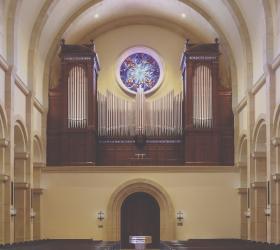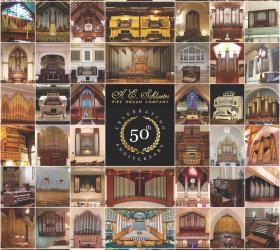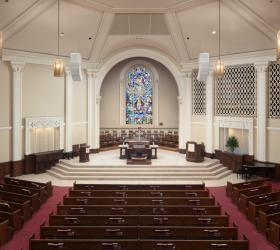
Bigelow & Co. Organ Builders, American Fork, Utah
First United Methodist Church, Salt Lake City, Utah
From the builder
Bigelow & Co. specializes in mechanical action instruments that are both historically informed and innovative. It was, therefore, a bit of a reach to tackle the rebuild of what had once been a tubular pneumatic instrument. In retrospect, it has been a fascinating experience, made all the more enjoyable by the enthusiasm and support of the organist and many others at First United Methodist Church, Salt Lake City.
First United Methodist Church dedicated its new building on May 22, 1906, and the organ was dedicated six months later on December 7. The oldest document in the church’s archives pertaining to the organ is a contract with the firm of “Geo. Kilgen and Son,” dated January 29, 1924, in which the first item reads: “To electrify the organ now located in their church using the most modern type action with silver contacts, brass encased magnets and paraffine [sic] cables.” That contract included several tonal changes as well, such as replacing the Great Mixture with a Flute Celeste, replacing the Dolce Cornet with a Vox Humana, and so on.
From the 1924 contract stoplist and other physical clues we made an educated guess as to the 1906 stoplist:
GREAT
16′ Dbl. Open Diapason*
8′ Open Diapason*
8′ Viol d’Gamba*
8′ Dulciana
8′ Melodia
8′ Dopple Flute [sic]*
4′ Octave*
4′ Flute d’Amour*
22⁄3′ Twelfth
2′ Fifteenth*
III Mixture
8′ Trumpet*
SWELL
16′ Bourdon (TC)*
8′ Open Diapason*
8′ Salicional
8′ Aeoline
8′ Stop Diapason*
8′ Quintadena
4′ Fugara*
4′ Flute Harmonic*
2′ Flageolet*
III Dolce Cornet
8′ Cornopean*
8′ Oboe*
PEDAL
16′ Open Diapason*
16′ Bourdon*
8′ Violincello [sic]*
*Ranks that survive with all or most of
their pipes
A photograph from 1915 reveals a handsome case with stenciled façade pipes (all speaking) covering an opening sixteen feet wide and twenty feet high. Unfortunately, in conjunction with a 1960 “Sanctuary and Chancel Beautification Project,” the beautiful oak casework was discarded and the façade pipes hidden from view. The organ was re-leathered and modified at that time. But, alas, by the 1980s the old ventil chests and actions were failing again. A hybrid electronic instrument provided a quick and economical solution. After Scott R. Mills was hired as organist, the congregation moved toward a more comprehensive restoration of their historic instrument, including a faithful reconstruction of the original oak casework and stenciled façade.
Realizing that many of the original pipes had been discarded or seriously altered, the church purchased nearly forty ranks of Kimball and Austin pipework, including harp and chimes, from the nearby Masonic temple, where that organ had been sitting idle for over twenty years. After examining what was left of the original Kilgen organ and additions, listening to whatever was playable, reviewing the inventory acquired from the Masonic temple, and perusing old photographs, we contracted with the church to “restore” and enlarge their historic organ. Adding only two new stops (four ranks of small pipes), the current three-manual specification was developed.
Most pipes of the Great, Swell, and Pedal divisions stand on their original ventil or unit chests, re-leathered and re-electrified by Bigelow. It is interesting that the ventil chests are in the style of Roosevelt, and may have come from an earlier Farrand & Votey instrument. That firm had been active in Utah in the 1890s, when they had recently acquired Roosevelt’s patents. One wonders: did the previous Methodist church, located about a block away, have a Farrand & Votey organ that Kilgen subsequently moved and adapted to the new space? The discovery of very old modifications to those chests and to the swell box make such a scenario seem likely.
The main Choir chest is a new Blackington-style slider chest by Organ Supply Industries. That firm also supplied electro-pneumatic unit and offset chests used variously throughout the organ and several single-rise regulators.
A 1930s “Style A” console was acquired from the Austin factory, and Jack Nelson of Nelson Woodworking re-surfaced the old worn-out ivory keys with new unbleached bone. The new stop-action magnets and control system are from Syndyne.
With the completion of this instrument, Bigelow is pleased and proud to claim responsibility for all three of Salt Lake City’s most recent three-manual organs, all very different from each other, and each one uniquely beautiful.
—Michael Bigelow
From the organist and
choir director
The vital ministry of First United Methodist Church (FUMC) of Salt Lake City, Utah, began just a few short months after the completion of the transcontinental railroad in 1869 when the Central Pacific and Union Pacific Railroads were finally joined at Promontory Point on the north shore of the Great Salt Lake. Methodist missionaries began arriving in Utah to organize churches and schools.
The first Methodist worship services were held in downtown Salt Lake City in an unfinished hay loft over a livery stable in May 1870. A year and a half later, the cornerstone was laid, and by December our congregation was holding services on the opposite block in the basement of our first new building. By 1905, it was determined to build a larger building (about a block away) to house the growing congregation. Frederick A. Hale, a prominent architect in the Mountain West, designed the building in the Victorian Eclectic architectural style. Although he was responsible for several church buildings in Colorado, this was his only one in Utah.
The FUMC organ has been in its original location since 1906, thus known as one of the oldest organs in the area. There are two older organs in Utah. First Congregational Church actually touts the oldest organ in the region (Farrand & Votey, 1892; renovated in 1992 by H. Ronald Poll & Assoc.), and First United Methodist Church of Ogden, Utah, possesses an organ which has been in storage for some time.
The earliest photo we have of our sanctuary is dated “Easter 1915.” The pipes were stenciled and were various shades of green in color. The organ console sat near the pipes so that the organist had a view of the congregation. The stage area was open. To get to the choir loft below the stained glass windows, members had to pass through the organ chamber—the door can be seen in the middle of the photo. We have members who have recalled as little children “running through the pipes” to get to the choir loft.
In the 1930s, the front façade pipes received the first of three paint-overs that occurred over the years with a dull gold color. The organ console was moved down to the main floor of the sanctuary during the tenure of organist and music director Dr. Frank W. Asper, who served from 1924–1939. He conducted a 30-voice choir and gave weekly organ recitals before worship. Dr. Asper was also a Mormon Tabernacle organist, serving from 1924–1965.
In 1960, at the time of the sanctuary and chancel beautification project, the organ façade pipes were moved back and a translucent screen placed behind a wooden grille. A set of crosses were placed in front of the screen and lights installed behind the screen. The pipes were no longer visible. Permanent pulpits were added with flower boxes and a new seating arrangement with benches for the choir loft. Since then, there have been several remodeling and renovation efforts, the last major one in 1989. The organist at the time requested that the church have the organ fixed so that it would be reliable. One can be grateful that they did not discard the historic pipes or chests. Due to financial restraints at the time, the church augmented the working components of the organ with an electronic Rodgers organ. The façade pipes were brought back out to be seen in the sanctuary with new woodwork framing the pipes. The inaugural concert was given by American concert organist and principal organist of the Wanamaker Organ, Keith Chapman, about three months before his untimely death.
When I was hired as the organist in 2008, I could tell that the organ was in need of significant repair. So we embarked on that possibility. The pipes were tuned and amid the ciphers, we could hear the potential warmth and beauty that the organ had to offer.
In November 2009, we launched a fundraising campaign to raise money to restore the organ and sanctuary back as close as possible to its original roots, keeping with its integrity, period, and design. The organ project included re-establishing the organ’s unique 1900s tonal style, its organ case from the 1915 photo, a vintage console, and augmenting its character with other vintage components. After looking around the country for vintage components, we found what we needed in our own backyard at the Salt Lake Masonic Temple. The organ at the Masonic Temple was originally in the American Theatre, a 3,000-seat silent movie theatre and the largest in Utah at the time, which was located on Main Street in downtown Salt Lake City. The instrument was originally built by the W. W. Kimball Company. The Austin Organ Company enlarged the organ in 1915 (Opus 609). In 1917, Alexander Schreiner, later a Mormon Tabernacle organist for 53 years, was playing on this organ as a high school student purportedly making more money than his teachers. Near the end of the silent movie era, local organists had the vision to preserve the organ and move it from the American Theatre to the new Masonic Temple building that had been finished in 1927.
By 2014, with donors attending and supporting organ recitals by community organists, grant writing, and a very successful crowd-funding campaign, we had raised sufficient funds to hire Bigelow & Co. of American Fork, Utah. We removed the Rodgers console and purchased a console that had been built in about 1930 that had previously been part Austin Opus 1702 in the Old St. Mary’s Catholic Church of Cincinnati, Ohio. Bigelow restored the original finish of the console and replaced the insides with state-of-the-art controls. We hired Tony Devroude of Artisan Organ to stencil the pipes. With his experience and expertise, Tony was able to recreate the original paint colors and stenciling designs, returning the original façade pipes back to their majestic beauty. He established the colors and designs by carefully peeling away layers of paint. Tony also turned the beautiful round middle tower base, crafted much of the case ornament including the four pineapples on top and the wooden dummy “stubby” pipes in the two arched openings. Finally, we removed the carpet in the front of the sanctuary and the 1960s paneling and opened up the chancel area. Thus, we have brought back the “look and feel” of the original sanctuary space with the tremendous sound of the organ now known as the Wesleyan Heritage Organ, Bigelow Opus 38 (2015).
“Methodism was born in song.” The music and liturgy of the worship at First United Methodist Church of SLC will return to its former glory. This was a true church and community effort. We are grateful to the members of FUMC, the many, many donors in the community, to the many workers with the remodeling of the sanctuary, and especially to the remarkable craftsmanship of Bigelow & Co. and for their meticulous care and expertise in preserving this historical organ. Our hearts are full of gratitude for their tireless efforts in making our dream become a reality.
Preserving these instruments (First Methodist and the Masonic Temple) with their treasured history provides a significant connection with our past and provides a sustaining commitment to who we are as a people in our worship to God.
—Scott R. Mills, Principal Organist/Music Coordinator
Bigelow & Co., Opus 38
Rebuild/enlargement of 1906/1924 Kilgen
Three manuals and pedal: 61/32 notes
42 ranks: 36 voices + 19 transmissions = 55 stops; 2 percussions.
Two additional stops (one rank/voice) are prepared for future addition.
GREAT (Manual II, unenclosed)
16′ Dbl. Open Diapason
8′ Open Diapason
8′ Doppel Flute
8′ Dulciana (Choir)
4′ Octave
4′ Hohl Flute
22⁄3′ Octave Quint [O]
2′ Super Octave
III Mixture (17.19.22) [O]
8′ Trumpet (Choir)
8′ Tuba*
Choir to Great 16
Choir to Great 8
Choir to Great 4
Swell to Great 8
Swell to Great 4
Chimes*
SWELL (Manual III, enclosed)
16′ Lieblich Gedackt
8′ Open Diapason
8′ Salicional
8′ Voix céleste (TC) [A]
8′ Stopped Diapason
4′ Fugara
4′ Flute Harmonic
2′ Flautino [O]
III Cornet [A]
III Mixture (15.19.22) [N]
16′ Contra-Bassoon [A]
8′ Cornopean [A]
8′ Oboe
8′ Vox Humana [O]
Tremulant
Unison Off
Swell to Swell 4
16′ Tuba (T.C.)*
8′ Tuba*
4′ Tuba*
CHOIR (Manual I, enclosed)
8′ Geigen Principal [A]
8′ Dulciana [A]
8′ Melodia [A]
8′ Quintadena [A]
4′ Gemshorn [A]
4′ Flute d’Amour
2′ Flageolet
11⁄3′ Nineteenth [N]
8′ Trumpet
8′ Clarinet [O]
Tremulant
8′ Harp (TC)* [A]
4′ Celesta* (extension)
Choir to Choir 16
Unison Off
Choir to Choir 4
Swell to Choir 8
Swell to Choir 4
16′ Tuba (T.C.)*
8′ Tuba*
4′ Tuba*
PEDAL
32′ Open Resultant (from Open Diap.)
32′ Stopped Resultant (from Sub Bass)
16′ Open Diapason (wood)
16′ Principal (Great 16′)
16′ Sub Bass
16′ Lieblich Gedackt (Swell)
8′ Principal (Great 16′)
8′ Cello
8′ Bourdon (prepared)
4′ Principal (Great 16′)
4′ Bourdon (prepared extension)
16′ Tuba (extension)
16′ Contra-Bassoon (Swell)
8′ Tuba
8′ Trumpet (Choir)
8′ Bassoon (Swell 16′)
Great to Pedal 8
Choir to Pedal 8
Choir to Pedal 4
Swell to Pedal 8
Swell to Pedal 4
Chimes
*Does not couple
[A] From Kimball/Austin
[N] New pipes
[O] Vintage pipes from another source
Electro-pneumatic action, including rebuilt ventil chests for Swell and Great
Solid state switching and multi-level combination action
Most pipework is early 20th-century Kilgen and Austin.




